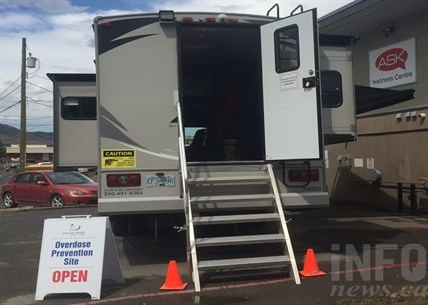
The mobile overdose prevention unit in Kamloops serves drug users downtown and on the city's North Shore. RCMP have set up atoms around the sites to track the number of issues being reported.
Image Credit: FILE PHOTO
September 08, 2017 - 4:30 PM
KAMLOOPS - Since rolling into Kamloops earlier this year, the mobile overdose prevention sites have been sheltering hundreds of people while they take their drugs, but no one is pretending it's a perfect answer to the city's overdose crisis.
It may very well save lives, but we already know some of the issues to the wider community, like a nearby daycare centre where discarded needles have been found.
“That’s a concern for me, that’s a huge concern,” Kamloops RCMP Insp. Sunny Parmar says. “Kids don’t know what needles are, they have no idea they could get poked. It’s one of those things where we want to help, we provide the needles, but now we have to move forward and go, OK how do we get them back?”
Police, Interior Health, social agencies, the City of Kamloops and the community at large are focussed on the overdose crisis but they aren't ignoring the issues they may cause. They are trying to gauge exactly what the issues are so they can be measured and addressed.
Since the prevention sites have opened, Kamloops RCMP developed 'atoms' around them, one located on Seymour Street behind the Crossroads Inn, and the other behind ASK Wellness off Tranquille Road on the city’s North Shore. The atoms allow police to track the number and types of calls they’re receiving within about a five-block radius of the RV.
Parmar says this year will be a baseline for years to come and allow the city’s Community Action Team to develop strategies once numbers are there.
“When we were having the discussions with Interior Health, they wanted us to report stats to them as well,” Parmar says. “We can’t give them a blanket stat ‘hey here’s what the city looks like.’ They won’t have an idea. We created an atom around (both sites) so that we could give very specific stats. Whether they were directly related to those locations, (we) can’t say.”
There have been hundreds of calls per month for police service in the radius of both overdose prevention sites, but there’s no way to know if the calls for service are directly linked to the sites. Many calls have been for what police call “safe streets” issues, like vagrancy and transient complaints, some of which aren’t criminal acts.
“We tend to think of homelessness as a crime,” Parmar says. “Being homeless is not a crime. I mean, what’s the offence?
“Maybe that person doesn’t need to be criminalized. We don’t need to put them through the legal system. What they need is actual help…. They need help getting themselves back on their feet.”
In June, the downtown atom around the overdose prevention site had 401 calls for service, July had 580, and from Aug. 1 to Aug. 15, there were 216 calls for service. In total, that’s nearly 1,200 calls for service in two-and-a-half months in a specific area, many of them safe streets complaints, intoxicated in a public place, causing a disturbance, and suspicious persons.
Similar numbers are present in the North Shore atom. In June there were 446 calls for service, in July 543 and from Aug. 1 to Aug. 15 there were 211, again totalling about 1,200 calls. Many of those were attributed to social issues like the downtown atom.
“We’ve started breaking it down into ones that we know Interior Health is going to want to look at,” Parmar says. “Those kinds of calls, social issues, things that affect their ability to assess what’s going on as well.”

(MIKE MCDONALD - REPORTER / iNFOnews.ca)
ASK Wellness executive director Bob Hughes has been vocal about a coordinated response to addictions issues. He believes in a four-pillar approach to addressing addictions, mental health, and homelessness issues.
A four-pillar drug strategy consists of harm reduction, prevention, treatment and enforcement, and all of those parts must work together if issues around homelessness and addiction will be solved, Hughes says.
“I don’t think it’s one or the other, I think we have to work together,” Hughes says. “I’m really hoping that we made some great inroads in terms of the partnership between enforcement, and bylaws, and Interior Health, and our organization, but I still think it’s a work in progress and we need to acknowledge that each pillar is valuable and essential.”
Hughes says the number of calls for service within these atoms aren’t necessarily indicative of a spike in crime, and he hopes the community doesn’t take it that way.
“Simple call outs to these locations does not necessarily mean that there’s some kind of rise or spike, it could well be that people feel like they’re willing to make the phone call to RCMP to have a response,” he says. “If we’re going to collect that data and look at it collectively and work toward a common solution… it isn’t just simply data that is being thrown in our face that says ‘see how bad this is around these areas because of the supervised consumption sites’.”
While agencies across the province deal with the public health emergency that was declared last year due to fentanyl-related overdoses, Hughes says it’s important to come up with short-term solutions while focusing on the bigger picture.
“While we are trying to figure out better solutions to the addictions crisis, I believe we need to continue to save the lives of these people,” he says.
According to Interior Health, 900 people have used the overdose prevention sites in Kamloops from the beginning of June to the end of July. In Kelowna, the number is much higher at 2,400 patients. Mental health and addictions administrator for Interior Health west, Rae Samson, says between the two cities, 700 people have been referred to outside services like treatment and detox since June.
“We really can see in the short time that we’ve been open that we’re meeting a need which is great to see,” Samson says.
Since the concept is virtually brand new, Samson says Interior Health didn’t have an anticipated number for how many people would be visiting the sites. But now that Interior Health and the RCMP are keeping track of what’s going on both inside and outside the units, it’ll help develop strategies for the future.
The issues around overdose prevention sites go past police officers and health workers. Kamloops’s Community Action Team will play a role in evaluating how the overdose prevention site is impacting the city, Samson says.
The team is made up of RCMP, Interior Health, ASK Wellness, bylaws, the City of Kamloops, and business owners, and Samson says their feedback will be taken into consideration moving forward.
“The community action team has been really helpful to Interior Health in terms of helping to guide the direction of the development of addictions services, certainly for the supervised consumption service,” she says. “But also, it has us talking much more broadly as a community about how we want to raise awareness around addictions and how we want to promote healthy living in our community.”
To contact a reporter for this story, email Ashley Legassic or call 250-319-7494 or email the editor. You can also submit photos, videos or news tips to the newsroom and be entered to win a monthly prize draw.
We welcome your comments and opinions on our stories but play nice. We won't censor or delete comments unless they contain off-topic statements or links, unnecessary vulgarity, false facts, spam or obviously fake profiles. If you have any concerns about what you see in comments, email the editor in the link above.
News from © iNFOnews, 2017